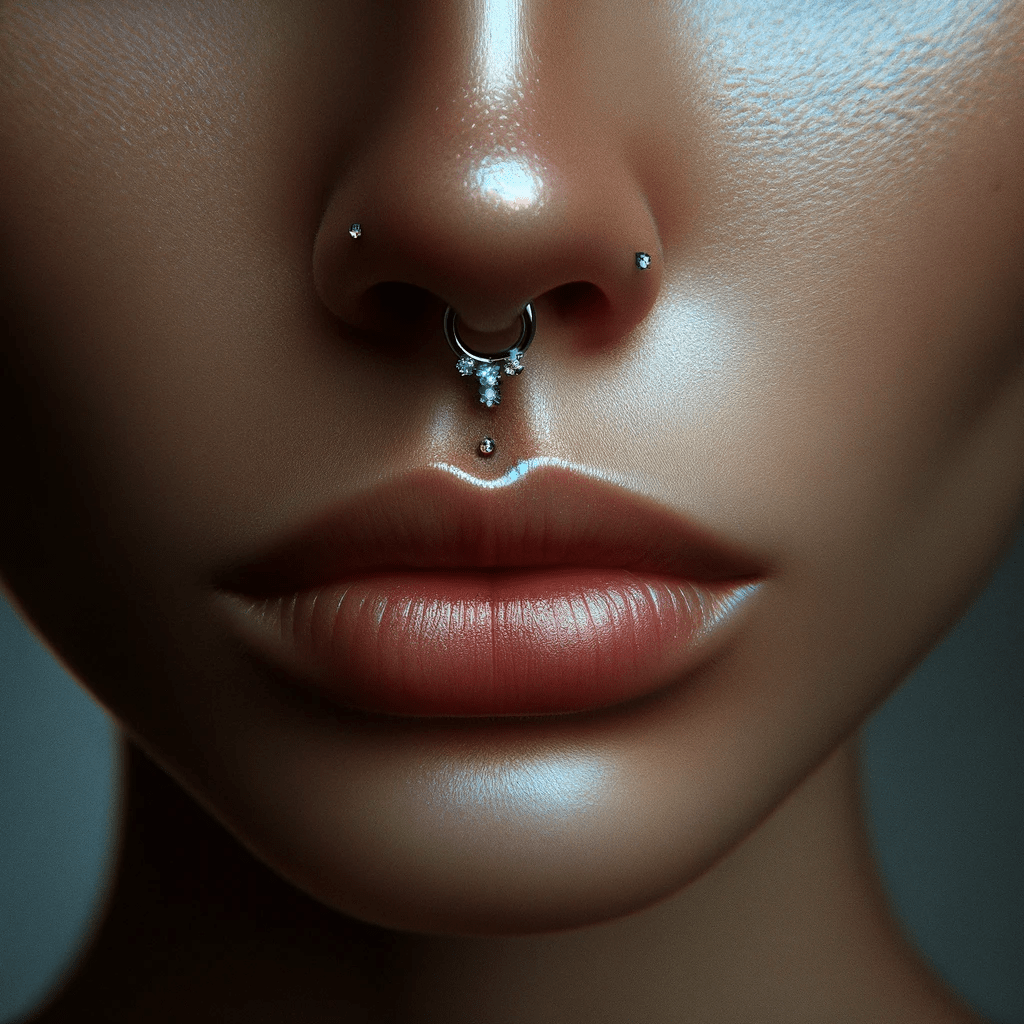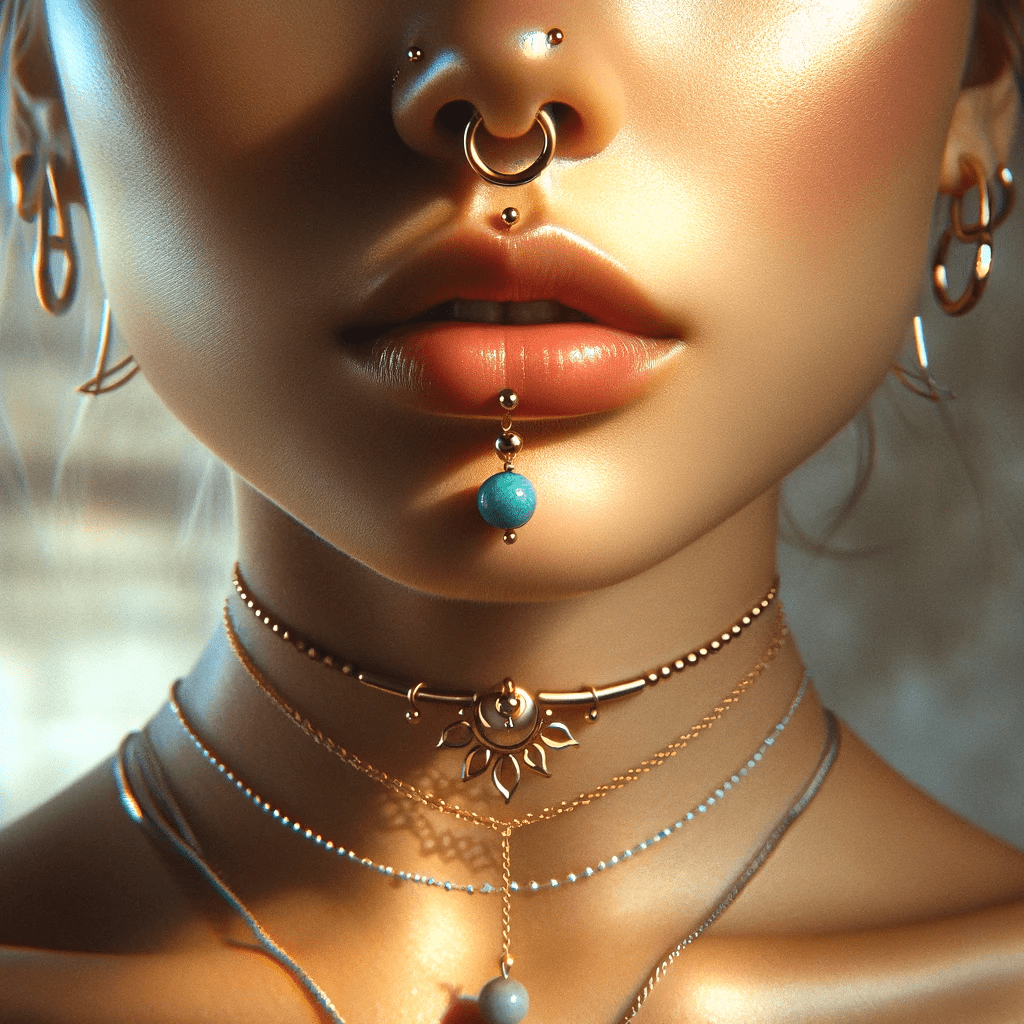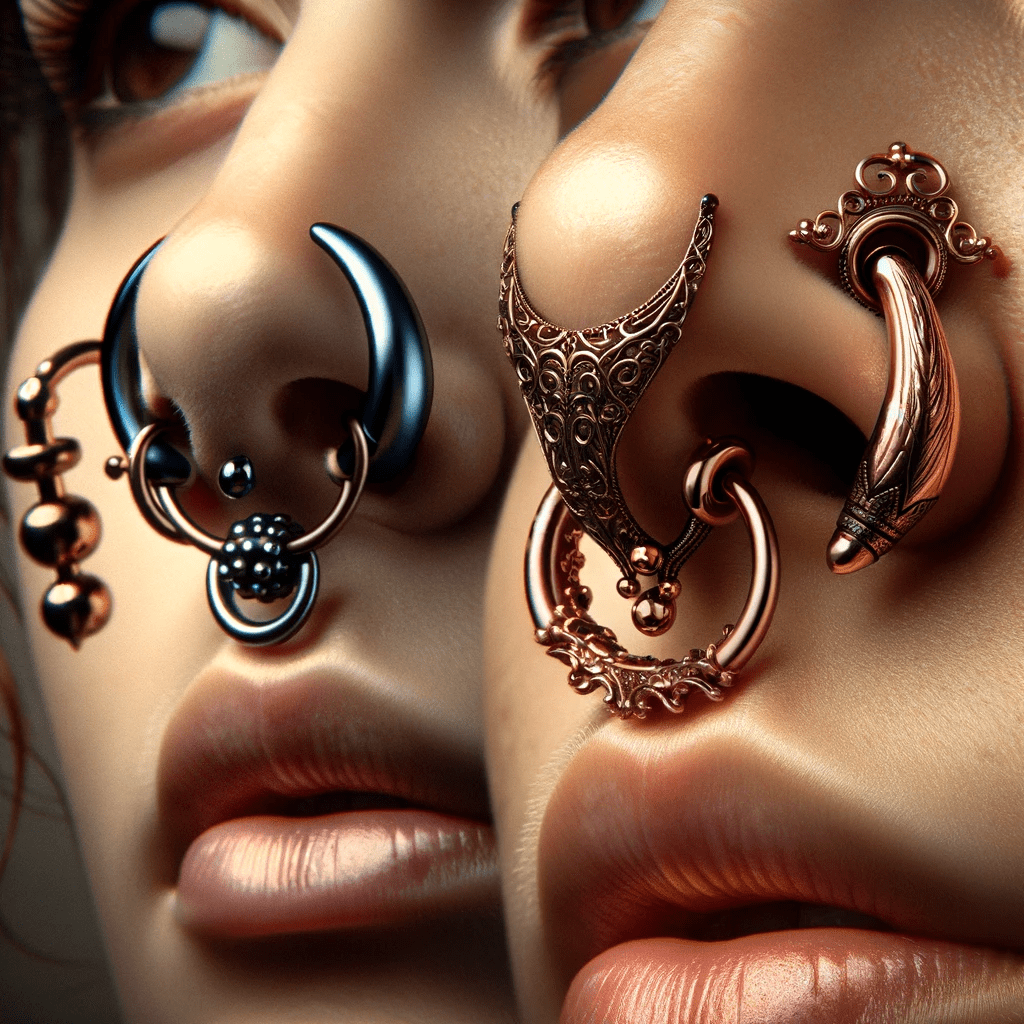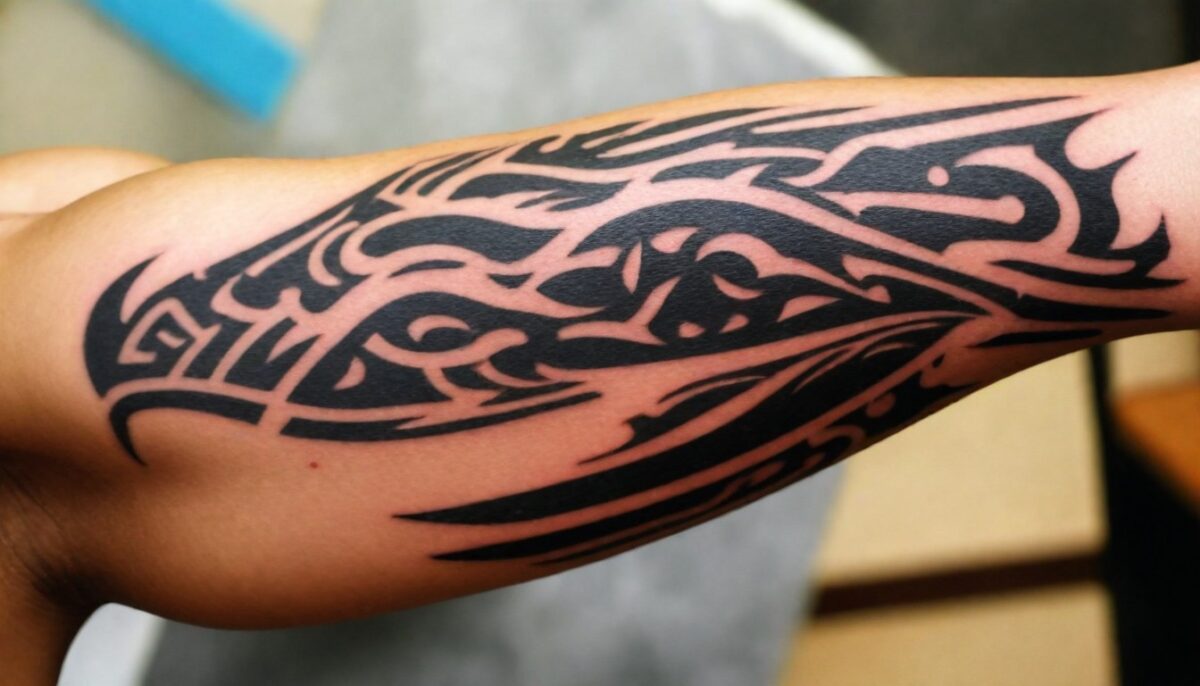Welcome to our comprehensive guide on septum piercings, your go-to resource for everything from the latest septum piercing styles to in-depth care tips.
Septum Piercings: Everything You Need to Know
Septum piercings have gained significant popularity in recent years, becoming a stylish and trendy body modification for many people. Though septum piercings may seem intimidating, they can be a relatively painless and straightforward process when performed by an experienced professional. If you’re considering a septum piercing, this article will provide you with everything you need to know to make an informed decision.
Historical and Cultural Context of Septum Piercings
Septum piercings, more than just a modern fashion statement, have a deep-rooted history that spans various cultures and epochs. This ancient practice, which involves piercing the cartilage wall between the nostrils, has been a significant part of cultural expression, spiritual beliefs, and social status in numerous societies.
Ancient Beginnings and Tribal Significance
- Indigenous Tribes: Among the earliest adopters of septum piercings were indigenous tribes across the globe. In regions such as Papua New Guinea and Solomon Islands, septum piercings were not only a rite of passage but also a symbol of strength and ferocity. Warriors often wore tusks and bones through their septums to intimidate enemies in battle.
- Native American Cultures: In North America, certain Native American tribes viewed septum piercings as a sacred ritual. They were often associated with spiritual journeys, marking significant transitions in life.
Symbolism and Social Status
- Ancient Maya and Aztec Societies: For the Maya and Aztecs, septum piercings held great symbolic value, often indicative of one’s status in society. Nobility and high priests adorned their septums with elaborate and ornate jewelry made from jade, gold, and silver, signifying their power and connection to the divine.
- Australian Aboriginal Communities: In Australian Aboriginal cultures, septum piercings signified a transition from adolescence to adulthood, a practice that was both a rite of passage and a communal bonding experience.
Modern Revival and Expression
- 20th Century Revival: The late 20th century witnessed a resurgence of septum piercings, largely influenced by the punk and alternative subcultures. It became a form of rebellion against conventional beauty standards and a symbol of individuality.
- Contemporary Trends: Today, septum piercings have transcended their traditional roots and are embraced by diverse groups of people worldwide. They are seen as a form of self-expression, an accessory to one’s personal style, and, for some, a nod to their cultural heritage.
Inclusivity and Diversity
- Gender Neutral Appeal: Septum piercings are unique in their gender-neutral appeal, embraced by all genders as a means of expressing identity and style.
- Cross-Cultural Adoption: The piercing has found its place in various subcultures and fashion trends, symbolizing the blurring of cultural lines in an increasingly globalized world.
By understanding the rich historical and cultural context of septum piercings, we gain insight into how this ancient practice has evolved and why it continues to hold significant meaning and appeal in modern society. From a symbol of status and strength in ancient civilizations to a mark of individuality and style in the present day, septum piercings remain a fascinating and enduring form of body art.
What is a septum piercing?
Septum piercings can be adorned with various types of jewelry, such as captive bead rings, circular barbells (horseshoe-shaped), seamless rings, clickers (hinged rings with a secure closure), and septum retainers (for a more discrete look). When choosing jewelry for a septum piercing, it’s essential to consider the material, size, and style that best suit your preferences and lifestyle. Common materials include surgical steel, titanium, niobium, and gold. It’s crucial to avoid nickel, as it can cause allergic reactions for some individuals.

The pain experienced during a septum piercing varies from person to person, but many individuals describe it as less painful than they anticipated. The discomfort is usually brief, and the healing process is relatively quick. A septum piercing typically takes 6-8 weeks to heal fully, although it may take longer for some individuals.
Proper aftercare is essential for a septum piercing to prevent infection and promote healthy healing. It’s important to clean the piercing twice a day with a saline solution or a pre-made piercing aftercare spray, avoid touching the piercing with unwashed hands, and refrain from rotating or moving the jewelry unnecessarily. Also, it’s advised not to submerge your piercing in pools, hot tubs, or other bodies of water until it is fully healed and to avoid applying alcohol, hydrogen peroxide, or other harsh chemicals to the piercing.
Potential risks and complications associated with septum piercings include infection, migration or rejection, piercing through cartilage instead of the “sweet spot,” allergic reactions to jewelry materials, and a deviated septum (rare). By choosing an experienced, professional piercer and adhering to proper aftercare, you can minimize these risks.
In conclusion, a septum piercing can be an exciting and unique way to express your individuality. By understanding the process, choosing the right jewelry, and committing to proper aftercare, you can enjoy a successful septum piercing experience. Always consult with a reputable professional piercer to ensure the best results and to address any concerns you may have.
Types of jewelry
There are several types of jewelry available for septum piercings, each offering a unique look and style. Some popular options include:
- Captive Bead Rings (CBR): These are circular rings with a small bead that holds the ring in place. The bead is either fixed to one side and has a small dimple on the other side for the ring to clip into, or it is held in place by the tension of the ring itself.
- Circular Barbells: Also known as horseshoe barbells, these are shaped like a horseshoe with two removable balls or other decorative ends that screw onto the exposed ends of the barbell. Circular barbells offer versatility, as the ends can be changed to match different styles or preferences.
- Seamless Rings: As the name suggests, seamless rings have no visible seams or connections, creating a smooth, continuous loop. They are usually made from a single piece of metal that is bent into a circle, with one end inserted into a tiny hollow tube on the other end.
- Clickers: Clickers are hinged rings that feature a secure closure, making them easy to insert and remove. They come in various designs, from simple and sleek to intricate and ornate, offering plenty of options for personalizing your septum piercing.
- Septum Retainers: These are designed to be more discrete, making them ideal for situations where you may need to hide your septum piercing, such as work or formal events. Septum retainers are typically made from a U-shaped or staple-shaped piece of metal, glass, or plastic that sits flush against the septum, making the piercing less noticeable.
When choosing jewelry for your septum piercing, it’s essential to consider factors such as material, size, and personal style. Common materials include surgical steel, titanium, niobium, and gold. Avoid nickel-containing jewelry, as it can cause allergic reactions in some individuals.
The piercing process
The septum piercing process typically involves several steps, which are carried out by an experienced professional piercer to ensure accuracy, safety, and minimal discomfort. The steps are as follows:
- Consultation: Before the piercing, you will have a consultation with the piercer to discuss your expectations, any concerns you may have, and potential allergies to certain metals. This is an opportunity to ask questions and ensure you are comfortable with the procedure.
- Marking: The piercer will use a non-toxic, skin-safe marking pen or a small dot of ink to mark the entry and exit points for the needle on your septum. This helps to ensure accurate placement and alignment of the piercing. You can check the markings in a mirror to confirm you are satisfied with the proposed location.
- Clamping: A small, specialized clamp is used to hold and stabilize the septum in place. This ensures a precise piercing and can minimize the risk of the needle slipping or the piercing being off-center. The clamp also helps to isolate the “sweet spot” – the thin area of soft tissue and minimal cartilage where the piercing should be placed.
- Piercing: The piercer will pass a sterilized, single-use needle quickly and cleanly through the septum at the marked points. The needle is usually slightly larger than the jewelry to ensure a snug fit, reducing the risk of the jewelry moving around and causing irritation during the healing process.
- Jewelry insertion: Once the needle has created a hole, the piercer will insert the chosen jewelry, either by following the needle or by using a special tool called an insertion taper. This helps to minimize discomfort and ensure the jewelry is correctly positioned.
- Aftercare instructions: After the piercing is complete, the piercer will provide you with detailed aftercare instructions to help prevent infection and ensure proper healing. It’s essential to follow these guidelines and consult with your piercer if you have any concerns or issues during the healing process.
The entire septum piercing process generally takes just a few minutes, with the actual piercing itself lasting only a few seconds. It is important to choose a reputable, experienced piercer to ensure a smooth and successful experience.
Pain and healing
Pain and healing times for septum piercings can vary from person to person, but some general observations can help provide an idea of what to expect:
- Pain: The level of pain experienced during a septum piercing is subjective and depends on an individual’s pain tolerance. For many people, the pain is less intense than they initially anticipated. The actual piercing process is relatively quick, and the discomfort usually lasts only a few seconds. Some individuals might feel a sharp pinch or pressure during the piercing, while others might find it more tolerable. It’s important to remember that everyone’s experience is different.
- Healing: The healing process for a septum piercing is typically faster than other cartilage piercings. On average, a septum piercing takes about 6-8 weeks to heal fully. However, this timeframe can vary depending on factors such as the individual’s overall health, how well they adhere to aftercare guidelines, and their body’s natural healing abilities. During the healing process, it’s normal for the pierced area to be slightly tender, swollen, or red. These symptoms should gradually subside over time.
To promote proper healing and minimize discomfort, it’s essential to follow the aftercare instructions provided by your piercer. These generally include cleaning the piercing with a saline solution or pre-made piercing aftercare spray, avoiding touching the piercing with unwashed hands, and refraining from rotating or moving the jewelry unnecessarily.
Additionally, you should avoid submerging your piercing in pools, hot tubs, or other bodies of water until it’s fully healed and not apply alcohol, hydrogen peroxide, or other harsh chemicals to the pierced area. If you have any concerns or notice signs of infection, consult your piercer or a healthcare professional for guidance.

Detailed Healing Process for Septum Piercings
Embarking on the journey of getting a septum piercing involves understanding the healing process, which is crucial for proper care and maintenance. Here’s a week-by-week guide that outlines what you can typically expect during the healing period of a septum piercing.
Week 1: Initial Healing
- Immediate Aftermath: Right after piercing, it’s normal to experience some pain, redness, and swelling. The first few days are often the most uncomfortable.
- Care Tips: Regular cleaning with saline solution is crucial. Avoid touching or moving the jewelry unnecessarily. It’s also important to avoid smoking, alcohol, or anything that can impede healing.
Week 2-3: Early Recovery
- Reducing Symptoms: The initial discomfort should start to subside. Swelling goes down, and pain becomes less intense.
- Observation and Care: Continue with saline washes. Keep an eye out for any signs of infection like excessive redness, swelling, or pus. Maintain good hygiene and avoid submerging the piercing in water.
Week 4-6: Mid-Healing Stage
- Noticeable Improvement: By this stage, you’ll notice significant improvements. Pain and swelling should be minimal.
- Maintenance: Continue cleaning, but you can reduce the frequency if healing is progressing well. Be cautious of snagging the jewelry on clothing or towels.
Week 7-8: Late Healing Stage
- Almost Healed: The piercing is nearly healed, with no soreness in most cases. There might be some minor crusting around the jewelry.
- Care and Caution: Continue gentle cleaning. Avoid changing the jewelry yourself until fully healed to prevent irritation or injury.
Months 2-6: Full Healing
- Healed Piercing: By this time, your septum piercing should be fully healed, with no discomfort or discharge.
- Jewelry Changes and Long-Term Care: You can now safely change your jewelry. Even after healing, it’s important to maintain good hygiene and monitor for any late-onset complications.
Tips for Successful Healing
- Nutrition and Hydration: Maintain a healthy diet and stay hydrated to support your body’s healing process.
- Sleep and Rest: Ensure you get enough rest. Be careful not to put pressure on your nose while sleeping, especially in the early weeks.
- Avoid Irritants: Stay away from dusty or dirty environments. Don’t use alcohol-based products near the piercing.
- Listen to Your Body: If you notice any unusual symptoms or if the healing process seems delayed, consult with your piercer or a healthcare professional.
Post-Healing Considerations
- Regular Checks: Even after healing, occasionally check your piercing for signs of irritation, especially when changing jewelry.
- Professional Assistance: If you’re unsure about changing the jewelry for the first time post-healing, don’t hesitate to seek help from a professional piercer.
By understanding and following this detailed healing timeline, you can help ensure a smooth and successful healing process for your septum piercing. Remember, individual experiences may vary, and it’s always best to follow the specific advice of your piercing professional.
Aftercare
Proper aftercare is crucial for a septum piercing to ensure healthy healing and prevent complications such as infection. Following these general guidelines can help promote a smooth healing process:
- Cleaning: Clean the pierced area twice a day using a saline solution or a pre-made piercing aftercare spray. You can make a saline solution by dissolving 1/4 teaspoon of non-iodized sea salt in 8 ounces (240 ml) of distilled water. To clean the piercing, use a clean cotton swab or gauze pad soaked in the solution, gently wiping away any debris or dried discharge. Avoid using alcohol, hydrogen peroxide, or other harsh chemicals, as they can be too abrasive and hinder the healing process.
- Hands off: Touching your septum piercing with unwashed hands can introduce bacteria and lead to infection. Always wash your hands thoroughly with soap and water before touching your piercing, and avoid unnecessary handling of the jewelry.
- Don’t rotate or move the jewelry: Contrary to popular belief, rotating or moving the jewelry during the healing process can cause irritation and prolong healing. It’s best to leave the jewelry in place and avoid disturbing it, except for when cleaning the piercing.
- Avoid swimming: Submerging your piercing in pools, hot tubs, or other bodies of water can introduce bacteria and increase the risk of infection. Wait until your septum piercing is fully healed before engaging in activities that involve submerging your piercing in water.
- Be cautious with personal care products: When using facial cleansers, makeup, or other personal care products near the pierced area, be careful not to get them into the piercing, as they can cause irritation. Also, avoid using alcohol-based products or fragrances on or around the piercing site.
- Monitor for signs of infection: Keep an eye out for any signs of infection, such as increased redness, swelling, pain, or discharge that is yellow or green in color. If you suspect an infection, consult your piercer or a healthcare professional for guidance.
By adhering to these aftercare guidelines, you can help ensure a successful healing process for your septum piercing. If you have any concerns or questions during the healing process, it’s essential to consult with your piercer or a healthcare professional.

Potential complications
As with any body modification, there are potential risks and complications associated with septum piercings. Being aware of these risks can help you take necessary precautions and seek professional help if needed. Some potential complications include:
- Infection: Infection is a common risk associated with any piercing. Following proper aftercare guidelines and maintaining good hygiene can significantly reduce the risk of infection. Signs of infection include increased redness, swelling, pain, and discharge that is yellow or green in color. If you suspect an infection, consult your piercer or a healthcare professional.
- Migration or rejection: In some cases, the body may react to a septum piercing by slowly pushing the jewelry out, causing the piercing to migrate or be rejected altogether. Choosing high-quality, hypoallergenic jewelry and following aftercare instructions can help minimize this risk.
- Piercing through cartilage: If the piercing is not done in the “sweet spot” of soft tissue and minimal cartilage, it may result in a more painful experience and a longer healing process. An experienced, professional piercer should be able to identify the correct location for a septum piercing.
- Allergic reactions: Some individuals may experience an allergic reaction to the metal used in the jewelry. To minimize the risk of an allergic reaction, choose jewelry made from hypoallergenic materials such as surgical steel, titanium, niobium, or gold. Avoid nickel-containing jewelry, as it is a common allergen.
- Deviated septum: While rare, there is a possibility that a septum piercing could contribute to or exacerbate a deviated septum, which is a misalignment of the cartilage that separates the nostrils. If you have concerns about this, consult with a healthcare professional before getting a septum piercing.
By choosing an experienced, reputable piercer and adhering to proper aftercare guidelines, you can minimize the risks and potential complications associated with septum piercings. If you experience any issues or concerns during the healing process, consult your piercer or a healthcare professional for advice.
Septum Piercing
Placement: The septum, aka the layer of cartilage between the nostrils
Pricing: $40-$100
Pain Level: 7/10
Healing Time: Four to six months
Aftercare: Soak with saline solution two times per day and avoid unnecessary touching. Keep soap and skincare products away from the immediate area.
Visual Content: Explore Septum Piercing Styles and Jewelry
Discovering the right style for your septum piercing can be an exciting part of the journey. Our curated gallery features a diverse range of septum piercing styles and jewelry options. Through these high-quality images, you can explore various looks and find inspiration for your own piercing.
Captivating Jewelry Styles
- Captive Bead Rings (CBR): See how these classic and versatile rings can accentuate the septum piercing. Perfect for those who love a timeless look.
- Circular Barbells: Also known as horseshoe barbells, these pieces offer a unique, edgy appearance. Explore different designs, from simple metal finishes to those with decorative ends.
- Seamless Rings: For a sleek and minimalistic style, the seamless rings provide an understated elegance. Check out how they create a smooth, continuous loop in the septum.
- Clickers: These hinged rings come in a variety of intricate designs. Our gallery showcases everything from the understated to the ornate, demonstrating how clickers can be a statement piece.
- Septum Retainers: Ideal for those seeking a discreet option, retainers are perfect for work or occasions where you might want to keep your piercing less noticeable.
Real-Life Examples
- Diverse Fashion Choices: View how people from different backgrounds and fashion preferences style their septum piercings, offering a real-world look at how versatile these piercings can be.
- Inspirational Looks: From bold and daring to subtle and chic, our collection includes a range of styles that can inspire your septum piercing choice.
Understanding Size and Fit
- Size Variations: Learn about different sizes and gauges available for septum jewelry, helping you determine the best fit for your comfort and style.
- Customization Options: Explore how different jewelry materials and gemstones can be mixed and matched for a personalized look.
Gallery Features
- Zoom and Details: Our images come with zoom-in functionality, allowing you to observe the fine details of each jewelry piece.
- Descriptions and Information: Each image is accompanied by a brief description, giving you insights into the type of jewelry, material used, and styling tips.
By browsing through our visual content, you’ll gain a better understanding of what styles resonate with you and how different types of jewelry can complement your septum piercing. Remember, the choice of jewelry is not just about aesthetics but also about comfort and suitability for your lifestyle.
Note to the Readers: While this description outlines what an ideal gallery for septum piercings and jewelry would include, remember to actually view these images on our website to get the complete visual experience.
Personal Testimonials: Real Stories of Septum Piercings
Gaining insights from those who have experienced the process of getting and living with a septum piercing can be incredibly valuable. In this section, we present a collection of personal testimonials from individuals who have journeyed through the decision, piercing process, healing, and styling of their septum piercings.
Emma’s Story: Embracing the Change
“I’ve always been intrigued by body art but was nervous about making a statement as bold as a septum piercing. After months of contemplation, I finally took the plunge. The piercing process was less painful than I anticipated, and I was surprised by how quickly it healed. My biggest takeaway? Don’t let fear hold you back from expressing yourself.”
Alex’s Healing Journey
“As someone who’s not great with pain, I was apprehensive about the piercing process. However, my piercer was incredibly professional and talked me through every step. The initial week was a bit tough with some swelling, but with diligent aftercare, my piercing healed beautifully. It’s now my favorite form of self-expression.”
Jordan’s Style Evolution
“My septum piercing has become a central part of my style. I love experimenting with different types of jewelry — from bold clickers to subtle seamless rings. It’s amazing how a small piece of metal can so drastically alter your look and confidence.”
Maria’s Professional Balance
“Working in a corporate environment, I was concerned about how my septum piercing would be perceived. Fortunately, with septum retainers, I can easily flip up my piercing during work hours. It’s the perfect balance between my professional life and personal style.”
Sam’s Unexpected Lessons
“Getting a septum piercing taught me more than I expected. It was a journey in patience and self-care, especially during the healing process. It also became a conversation starter, helping me connect with others who share an interest in body modifications. This piercing is more than just a fashion statement; it’s a part of my identity.”
Lily’s Advice for Newcomers
“If you’re considering a septum piercing, my advice is to research and find a reputable piercer. Also, be prepared for the aftercare commitment. It’s worth it, though — every time I see my piercing in the mirror, it brings a smile to my face.”
Through these personal stories, potential piercees can gain a well-rounded view of what to expect and how a septum piercing can be a transformative and personal journey. Each story highlights the unique experiences and emotions tied to this form of self-expression.
Common Myths and Misconceptions About Septum Piercings
Septum piercings, like many forms of body modification, are surrounded by various myths and misconceptions. It’s important to separate fact from fiction, especially for those considering getting a septum piercing. Let’s address and debunk some of the most common myths.
Myth 1: Septum Piercings are Extremely Painful
- Reality: Pain is subjective, but many find that septum piercings are less painful than anticipated. The discomfort is often described as a brief, sharp sensation, followed by some tenderness. The experience varies from person to person, but it’s generally not considered to be excessively painful.
Myth 2: Septum Piercings Take a Long Time to Heal
- Reality: Compared to other body piercings, septum piercings have a relatively quick healing process, typically taking about 6-8 weeks for initial healing. Complete healing can take a few months, but this is faster than many other cartilage piercings.
Myth 3: You Can’t Hide a Septum Piercing
- Reality: One of the advantages of a septum piercing is its ability to be discreet. Septum retainers or certain types of jewelry can be flipped up into the nostrils, making the piercing virtually invisible when needed.
Myth 4: Septum Piercings Affect Your Ability to Breathe or Cause Constant Sneezing
- Reality: A properly done septum piercing does not impede breathing. While some initial swelling can occur, it doesn’t usually affect nasal airflow significantly. Also, once healed, the piercing shouldn’t trigger constant sneezing. Initial sensitivity can cause some sneezing, but this is typically temporary.
Myth 5: Septum Piercings are Only for Certain Types of People
- Reality: Septum piercings are incredibly diverse and can suit anyone regardless of their style or background. They have been embraced by a wide variety of cultures and individuals, making them a versatile choice for many.
Myth 6: Changing the Jewelry Frequently is Fine
- Reality: During the healing process, it’s important to avoid changing the jewelry frequently, as this can irritate the piercing and prolong healing. Once healed, the jewelry can be changed, but it should be done carefully and ideally with clean, sterilized jewelry.
Myth 7: Septum Piercings Leave a Noticeable Scar
- Reality: If you decide to remove your septum piercing permanently, it usually leaves a minimal, often unnoticeable scar. The location of the piercing inside the nose makes any scarring less visible compared to other facial piercings.
Myth 8: Septum Piercings are Always Infected
- Reality: While there is a risk of infection, as with any piercing, following proper aftercare significantly reduces this risk. Infections are not a given and can be effectively prevented with good hygiene practices.
By understanding and dispelling these myths, individuals can make a more informed decision about getting a septum piercing and feel more at ease about the process and its implications. Remember, consulting with a professional piercer can provide further clarity and personalized advice.
FAQs
Here are some frequently asked questions (FAQs) and their answers related to septum piercings:
How much does a septum piercing cost?
The cost of a septum piercing can vary depending on factors such as the piercer’s experience, the studio’s location, and the jewelry chosen. On average, septum piercings can cost anywhere from $30 to $90, not including the price of the jewelry. It’s important to prioritize safety and experience over cost when choosing a piercer.
How long does it take for a septum piercing to heal?
A septum piercing typically takes about 6-8 weeks to heal fully. However, healing times can vary depending on factors such as the individual’s overall health, adherence to aftercare guidelines, and their body’s natural healing abilities.
Can I hide my septum piercing?
Yes, you can hide a septum piercing by using a septum retainer or flipping up certain types of jewelry, such as a circular barbell or a small-diameter seamless ring, into the nostrils. A septum retainer is a discrete piece of jewelry designed specifically to be less noticeable when worn.
Will a septum piercing leave a visible scar?
When a septum piercing is removed or closed, it usually leaves a minimal scar that is not easily visible. The scar is typically hidden inside the nostrils, making it even less noticeable.
Can I change my septum jewelry myself?
After your septum piercing has fully healed, you can change the jewelry yourself. It’s essential to ensure your hands are clean and the new jewelry is sterile before attempting to change it. If you have any difficulties or concerns, consult your piercer for assistance.
How do I know if my septum piercing is infected?
Signs of infection may include increased redness, swelling, pain, or discharge that is yellow or green in color. If you suspect an infection, consult your piercer or a healthcare professional for guidance.
Can I get a septum piercing if I have a deviated septum?
While it is possible to get a septum piercing with a deviated septum, it’s essential to consult with a healthcare professional before proceeding. A piercer experienced with septum piercings can also provide guidance on whether a piercing is advisable in your specific situation.
Remember that individual experiences with septum piercings can vary. Always consult a reputable, experienced professional piercer for advice and guidance tailored to your unique circumstances.
The Daith Piercing: A Comprehensive Guide
27 Corset Piercings Images and Piercing Aftercare Information
21 Inner & Outer Conch Piercing Inspirational Examples
Everything you need to know about lip piercings
The Great Snake Eyes Tongue Piercing: What You Need to Know

